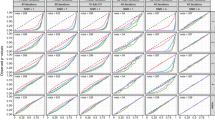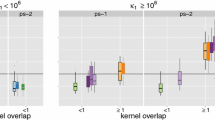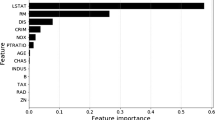Abstract
In this article we propose a boosting algorithm for regression with functional explanatory variables and scalar responses. The algorithm uses decision trees constructed with multiple projections as the “base-learners”, which we call “functional multi-index trees”. We establish identifiability conditions for these trees and introduce two algorithms to compute them. We use numerical experiments to investigate the performance of our method and compare it with several linear and nonlinear regression estimators, including recently proposed nonparametric and semiparametric functional additive estimators. Simulation studies show that the proposed method is consistently among the top performers, whereas the performance of existing alternatives can vary substantially across different settings. In a real example, we apply our method to predict electricity demand using price curves and show that our estimator provides better predictions compared to its competitors, especially when one adjusts for seasonality.








Similar content being viewed by others
References
Ait-Saïdi A, Ferraty F, Kassa R et al (2008) Cross-validated estimations in the single-functional index model. Statistics 42(6):475–494
Amato U, Antoniadis A, De Feis I (2006) Dimension reduction in functional regression with applications. Comput Stat Data Anal 50(9):2422–2446
Amiri A, Crambes C, Thiam B (2014) Recursive estimation of nonparametric regression with functional covariate. Comput Stat Data Anal 69:154–172
Avery M, Wu Y, Helen Zhang H et al (2014) RKHS-based functional nonparametric regression for sparse and irregular longitudinal data. Can J Stat 42(2):204–216
Baíllo A, Grané A (2009) Local linear regression for functional predictor and scalar response. J Multivar Anal 100(1):102–111
Barrientos-Marin J, Ferraty F, Vieu P (2010) Locally modelled regression and functional data. J Nonparametr Stat 22(5):617–632
Bates D, Mächler M, Bolker B et al (2015) Fitting linear mixed-effects models using lme4. J Stat Softw 67(1):1–48
Berlinet A, Elamine A, Mas A (2011) Local linear regression for functional data. Ann Inst Stat Math 63(5):1047–1075
Blumenson L (1960) A derivation of n-dimensional spherical coordinates. Am Math Mon 67(1):63–66
Boente G, Salibian-Barrera M (2021) Robust functional principal components for sparse longitudinal data. METRON 79(2):1–30
Breiman L, Friedman J, Olshen R et al (1984) Classification and regression trees, 1st edn. Routledge, Routledge
Burba F, Ferraty F, Vieu P (2009) K-nearest neighbour method in functional nonparametric regression. J Nonparametr Stat 21(4):453–469
Cardot H, Sarda P (2005) Estimation in generalized linear models for functional data via penalized likelihood. J Multivar Anal 92(1):24–41
Cardot H, Ferraty F, Sarda P (1999) Functional linear model. Stat Probabil Lett 45(1):11–22
Cardot H, Ferraty F, Sarda P (2003) Spline estimators for the functional linear model. Stat Sin 13(3):571–591
Carroll C, Gajardo A, Chen Y et al (2021) fdapace: functional data analysis and empirical dynamics. https://CRAN.R-project.org/package=fdapace, R package version 0.5.6
Chen D, Hall P, Müller HG et al (2011) Single and multiple index functional regression models with nonparametric link. Ann Stat 39(3):1720–1747
Dou WW, Pollard D, Zhou HH et al (2012) Estimation in functional regression for general exponential families. Ann Stat 40(5):2421–2451
Fan Y, James GM, Radchenko P et al (2015) Functional additive regression. Ann Stat 43(5):2296–2325
Febrero-Bande M, González-Manteiga W (2013) Generalized additive models for functional data. Test 22(2):278–292
Ferraty F, Vieu P (2002) The functional nonparametric model and application to spectrometric data. Comput Stat 17(4):545–564
Ferraty F, Vieu P (2006) Nonparametric functional data analysis: theory and practice. Springer, New York, NY
Ferraty F, Vieu P (2009) Additive prediction and boosting for functional data. Comput Stat Data Anal 53(4):1400–1413
Ferraty F, Peuch A, Vieu P (2003) Modèle à indice fonctionnel simple. CR Math 336(12):1025–1028
Ferraty F, Hall P, Vieu P (2010) Most-predictive design points for functional data predictors. Biometrika 97(4):807–824
Ferraty F, Park J, Vieu P (2011) Estimation of a functional single index model. In: Ferraty F (ed) Recent advances in functional data analysis and related topics. Physica-Verlag HD, Heidelberg
Ferraty F, Goia A, Salinelli E et al (2013) Functional projection pursuit regression. Test 22(2):293–320
Ferré L, Yao AF (2003) Functional sliced inverse regression analysis. Statistics 37(6):475–488
Friedman JH (2001) Greedy function approximation: a gradient boosting machine. Ann Stat 29(5):1189–1232
Geenens G et al (2011) Curse of dimensionality and related issues in nonparametric functional regression. Stat Surv 5:30–43
Goia A, Vieu P (2015) A partitioned single functional index model. Comput Stat 30(3):673–692
Goldsmith J, Scheipl F, Huang L, et al (2020) refund: regression with functional data. https://CRAN.R-project.org/package=refund, r package version 0.1-23
Gregorutti B (2016) RFgroove: importance measure and selection for groups of variables with random forests. https://CRAN.R-project.org/package=RFgroove, r package version 1.1
Gregorutti B, Michel B, Saint-Pierre P (2015) Grouped variable importance with random forests and application to multiple functional data analysis. Comput Stat Data Anal 90:15–35
Greven S, Scheipl F (2017) A general framework for functional regression modelling. Stat Model 17(1–2):1–35
Hall P, Horowitz JL et al (2007) Methodology and convergence rates for functional linear regression. Ann Stat 35(1):70–91
Hastie T, Mallows C (1993) A statistical view of some chemometrics regression tools. Technometrics 35(2):140–143
James GM (2002) Generalized linear models with functional predictors. J R Stat Soc Ser B (Stat Methodol) 64(3):411–432
James GM, Silverman BW (2005) Functional adaptive model estimation. J Am Stat Assoc 100(470):565–576
Jiang CR, Wang JL et al (2011) Functional single index models for longitudinal data. Ann Stat 39(1):362–388
Kara LZ, Laksaci A, Rachdi M et al (2017) Data-driven KNN estimation in nonparametric functional data analysis. J Multivar Anal 153:176–188
Kudraszow NL, Vieu P (2013) Uniform consistency of KNN regressors for functional variables. Stat Probabil Lett 83(8):1863–1870
Li KC (1991) Sliced inverse regression for dimension reduction. J Am Stat Assoc 86(414):316–327
Lian H, Li G (2014) Series expansion for functional sufficient dimension reduction. J Multivar Anal 124:150–165
Liebl D et al (2013) Modeling and forecasting electricity spot prices: A functional data perspective. Ann Appl Stat 7(3):1562–1592
Ling N, Vieu P (2018) Nonparametric modelling for functional data: selected survey and tracks for future. Statistics 52(4):934–949
Ling N, Vieu P (2020) On semiparametric regression in functional data analysis. Wiley Interdisciplinary Reviews: Computational Statistics 1538. https://doi.org/10.1002/wics.1538
Mas A et al (2012) Lower bound in regression for functional data by representation of small ball probabilities. Electron J Stat 6:1745–1778
McLean MW, Hooker G, Staicu AM et al (2014) Functional generalized additive models. J Comput Graph Stat 23(1):249–269
Möller A, Tutz G, Gertheiss J (2016) Random forests for functional covariates. J Chemom 30(12):715–725
Müller HG, Yao F (2008) Functional additive models. J Am Stat Assoc 103(484):1534–1544
Müller HG, Stadtmüller U et al (2005) Generalized functional linear models. Ann Stat 33(2):774–805
Müller HG, Wu Y, Yao F (2013) Continuously additive models for nonlinear functional regression. Biometrika 100(3):607–622
Preda C (2007) Regression models for functional data by reproducing kernel Hilbert spaces methods. J Stat Plan Inference 137(3):829–840
Reiss PT, Ogden RT (2007) Functional principal component regression and functional partial least squares. J Am Stat Assoc 102(479):984–996
Shang HL (2016) A Bayesian approach for determining the optimal semi-metric and bandwidth in scalar-on-function quantile regression with unknown error density and dependent functional data. J Multivar Anal 146:95–104
Telgarsky M (2013) Margins, shrinkage, and boosting. Int Conf Mach Learn 28(2):307–315
Therneau T, Atkinson B (2019) rpart: recursive partitioning and regression trees. https://CRAN.R-project.org/package=rpart, r package version 4.1-15
Tutz G, Gertheiss J (2010) Feature extraction in signal regression: a boosting technique for functional data regression. J Comput Graph Stat 19(1):154–174
Wang G, Lin N, Zhang B (2014) Functional K-means inverse regression. Comput Stat Data Anal 70:172–182
Wood SN (2017) Generalized additive models: an introduction with R, 2nd edn. Chapman and Hall/CRC, Boca Raton
Yao F, Müller HG, Wang JL (2005) Functional data analysis for sparse longitudinal data. J Am Stat Assoc 100(470):577–590
Zhang T, Yu B (2005) Boosting with early stopping: convergence and consistency. Ann Stat 33(4):1538–1579
Zhao Y, Ogden RT, Reiss PT (2012) Wavelet-based lasso in functional linear regression. J Comput Graph Stat 21(3):600–617
Acknowledgements
The authors would like to thank Professors James and Ferraty for sharing the code used in their papers (James and Silverman 2005; Ferraty et al. 2013). In addition, we would like to thank two anonymous referees and an Associate Editor for their constructive comments on an earlier version of this work that resulted in a notably improved paper.
Funding
This research was supported by the Natural Sciences and Engineering Research Council of Canada [Discovery Grant RGPIN-2016-04288].
Author information
Authors and Affiliations
Corresponding author
Ethics declarations
Conflict of interest
The authors have no competing interest to declare that are relevant to the content of this article.
Additional information
Publisher's Note
Springer Nature remains neutral with regard to jurisdictional claims in published maps and institutional affiliations.
Appendices
Appendix A
Proof of Theorem 1 in Sect. 2.1.1.
Proof
It is clear that if \(\{\beta _1,..., \beta _K \} = \left\{ (-1)^{l_1}\eta _1,..., (-1)^{l_K}\eta _K \right\}\) for some \(l_1,...,l_K \in \{0,1\}\), then \(g = {\tilde{g}}\). Therefore, it suffices to show that \(\{\beta _1,..., \beta _K \} = \left\{ (-1)^{l_1}\eta _1,..., (-1)^{l_K}\eta _K \right\}\) for some \(l_1,...,l_K \in \{0,1\}\). We prove that if there do not exist \(l_1,...,l_K\) for the two sets to be equal, there exists a set of indices for which (12) is a constant function and thus contradicts Condition 2.
For simplicity, we let \({\tilde{\eta }}_j = (-1)^{l_j} \eta _j\). If for any \(l_1,...,l_K\), \(\{\beta _1,..., \beta _K \} \ne \left\{ {\tilde{\eta }}_1,..., {\tilde{\eta }}_K \right\}\), we match two sets so that the same vectors \(\beta _j\) and \({\tilde{\eta }}_j\) align with each other. We let \(S = \{\beta _1,...,\beta _K \} \cap \{{\tilde{\eta }}_1,...,{\tilde{\eta }}_K \}\), \(\beta _j = {\tilde{\eta }}_j\), for \(j = 1,..., |S|\) and \(\beta _j \notin \{{\tilde{\eta }}_1,...,{\tilde{\eta }}_K \}\), for \(j = |S|+1,..., K\), and \(|S| < K\). By Condition 2, there exist a \(x_0\) for \(J = {|S|+1,...,K}\), (12) is not a constant function.
By (13), Conditions 1 and 2, for any \(t_1,..., t_K \in (-\delta , \delta )\)
and similarly
By Cauchy-Schwarz inequality and Condition 1, \((\langle \beta _j, \eta _j \rangle )^2 = 1\) for \(j = 1,..., |S|\) and \((\langle \beta _j, \eta _j \rangle )^2 < 1\) for \(j = |S+1|,..., K\). For any \(t_1,..., t_K \in (-\delta ,\delta )\),
where \(I_j = 1\) for \(j = 1,...,|S|\) and \(I_j = 0\) for \(j = |S+1|,..., |K|\).
Let \(x = x_0 + t e\) for any unit function \(e \in L^2({\mathcal {I}})\), \(\Vert e \Vert = 1\) and \(t \in (-\delta , \delta )\). Then x fills the space of \(B(x_0, \delta )\). For \(j = 1,...,K\), we define
which is a constant function of x and that contradicts Condition 2. \(\square\)
Appendix B
The summary statistics of test MSEs from 100 independent runs of the simulation are provided in Tables 2, 5, 8 and 11, with bold font indicating the lowest two average test errors in each setting. Summary statistics of the tree depths selected by TFBoost are provided in Tables 3,6, 9 and 12, and for the early stopping times for TFBoost are provided in Tables 4, 7, 10 and 13.
Figures 9, 10, 11 and 12 show the test MSEs averaged over 100 runs of the experiment versus the number of iterations for TFBoost. For the convenience of taking the averages, for each run, we let the test errors for the iterations past the early stopping time to keep the same test error as the one obtained at the early stopping time. It can be observed from figures that the test errors usually drop quickly within 100 iterations.
Appendix C
We consider another regression function that is linear:
The other specifications of the model remain the same as described in Sect. 3. Table 14 include the summary statistics of test MSEs from 100 independent runs of the simulation, with bold font indicating the lowest two average test errors in each setting. Tables 15 and 16 include the summary statistics of the tree depths and early stopping times selected by TFBoost methods.
Appendix D
The summary statistics of test MSEs from 100 random partitions of the German electricity data in Sect. 4 are provided in Table 17.
Rights and permissions
Springer Nature or its licensor (e.g. a society or other partner) holds exclusive rights to this article under a publishing agreement with the author(s) or other rightsholder(s); author self-archiving of the accepted manuscript version of this article is solely governed by the terms of such publishing agreement and applicable law.
About this article
Cite this article
Ju, X., Salibián-Barrera, M. Tree-based boosting with functional data. Comput Stat 39, 1587–1620 (2024). https://doi.org/10.1007/s00180-023-01364-2
Received:
Accepted:
Published:
Issue Date:
DOI: https://doi.org/10.1007/s00180-023-01364-2








